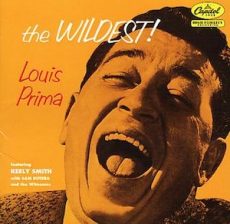
Daily Dose Of Jazz…
Louis Leo Prima was born December 7, 1910 in New Orleans, Louisiana into a musical Italian American family. His mother, a music lover, made sure that each child played an instrument, assigning him the violin and started out playing at St. Ann’s Parish. His interest in jazz came when he heard black musicians, including Louis Armstrong at a time Italians and Blacks in New Orleans frequently socialized together in the same clubs and bars.
He practiced continuously on his worn-down cornet and formed a band in 1924 with his childhood friends, bassist Candy Candido, Irving Fazola on clarinet and drummer Johnny Viviano. Prima attended Jesuit High School but transferred to Warren Easton High in 1926. There he played with the Eastonites, the school band. The next year he partnered with fellow musician Frank Federico and they played in the French Quarter.
By 1928 his decision was made to become a professional musician. After finishing high school he joined the Ellis Stratako Orchestra in 1929 then the Joseph Cherniavsky Orchestrafollowed by a temporary job playing on the steamship Capital that docked on Canal Street. His first break was when Lou Forbes hired him for daily afternoon and early evening shows at The Saenger.
1934 saw him begin recording for the Brunswick label. He recorded That’s Where the South Begins, Long About Midnight, Jamaica Shout, and StarDust. Prima and his New Orleans Gang featured Frank Pinero playing piano, Jack Ryan bass, Garrett McAdams guitar, and Pee Wee Russell clarinet. at the Famous Door. HIs recordings from 1935 were a combination of Dixieland and swing. He and Russell recorded The Lady in Red, a national jukebox hit. They also recorded Chinatown, Chasing Shadows and Gypsy Tea Room.
Martha Raye played a role in Prima’s professional and personal life and with her got his first national debut on The Fleischman Hour. He recorded Sing, Sing , Sing in 1936, which subsequently became a hit for Benny Goodman. Moving to California he expanded his music, joining the movement for big bands and orchestras. However for him the configuration was not successful.
He returned to New York City in 1937 with his quintet at the Famous Door. Then on to Billy Rose’s Casa Mañana club in 1938, earning nearly a quarter million dollars throughout seven weeks. This led to an East Coast to mid-West tour. During the war years, Louis was experiencing great success regardless of anti-Italian sentiment. He would go on to have several big hits but by the end of the war years, the popularity of big band music was diminishing. By 1947 he was playing more jazzy versions of his music for the next decade and a half.
Trumpeter, singer, entertainer and bandleader Louis Prima suffered a heart attack in 1973. Two years later he was diagnosed with a brain stem tumor, suffered a cerebral hemorrhage, went into a coma following surgery and never recovered. He moved back to New Orleans and transitioned three years later on August 24, 1978 at 67 in his hometown.
More Posts: bandleader,history,instrumental,jazz,music,trumpet


